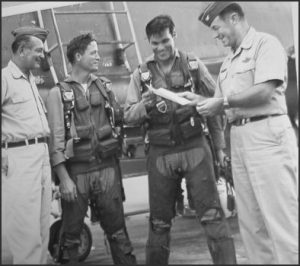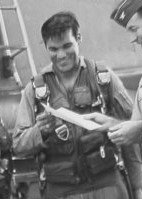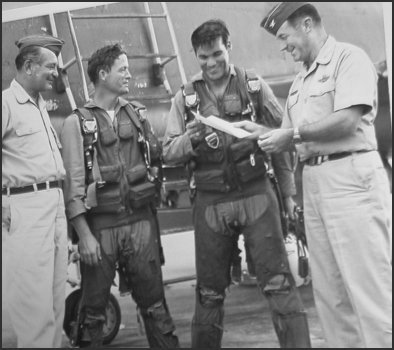After College, Pete Biddle headed to Pilot Training and upon completion asked for an F-100…but he was sent to Germany flying T-33 as Target (lots of bad weather and good all-weather flying)
During his Air Force career, Biddle was deployed to Vietnam twice, once from the Philippines.
After he left the Air Force, he joined the Air National Guard in Albuquerque, NM flying the F-100A. He left NM after they converted from F-100’s to the A-7D because the Air Defense mission was less Air to Air flying. Pete points out that a fully loaded F-100A weighed less than an F-100D without fuel! The “A’ was a rocket!!
 There I was, fat dumb and happy with a load of slick bombs over a target in SE Asia in July 1966. I had made a couple of successful bomb releases. But upon climbing to high key for another run, it was difficult to maintain my airspeed. My wingman said he didn’t see anything wrong. So, I went ahead and came down the chute (prophetic) again, but at the release point, the bird flamed out.
There I was, fat dumb and happy with a load of slick bombs over a target in SE Asia in July 1966. I had made a couple of successful bomb releases. But upon climbing to high key for another run, it was difficult to maintain my airspeed. My wingman said he didn’t see anything wrong. So, I went ahead and came down the chute (prophetic) again, but at the release point, the bird flamed out.
I was able to get a restart, but with little power. With about 220 knots and maybe 2,000 ft of altitude, I headed for base. I made it about halfway when she flamed out again. Restart attempts were unsuccessful. So, I pulled the handles, and the fun began.
The canopy and seat left my F-100 (I was sad because it was the last shiny bird remaining and it had my name painted on it) and I was free-falling, wondering when the chute was going to open until I realized the seat was still with me; no butt snapper. Upon shoving the seat away, my body went into a spin. I was able to stabilize with a spread eagle. I pulled the D-ring. This was the first time I said “Oh Shit”. I was still spread-eagled and I felt the chute go through my legs. Other than scaring the crap out of me, the chute worked pretty well.
After clearing a cord over the canopy, I settled down for the short ride to the ocean. I popped the cartridges on my life vest. Nothing happened, so I blew them up by mouth. Luckily, the seat cushion performed as it should. I wouldn’t have wanted to blow up the dingy by mouth. I opened the harness clips and waited for water entry; then released the parachute.
When I tried to mount the dingy, my feet were tangled in the shroud lines. Even though I had released the chute, the antenna for the beeper was so tight it remained attached. Typically, the source of most ejection problems was the survival vest. It was made of mesh. During the initial sequencing of the ejection, my body compressed and the lap belt handle became entangled with the mesh thereby opening the lap belt and negating the automatic stuff.
The aircraft problem was a failed M-1 accessory pack.
For you purists, Taiwan is part of Southeast Asia; and BDU33’s are slick.






